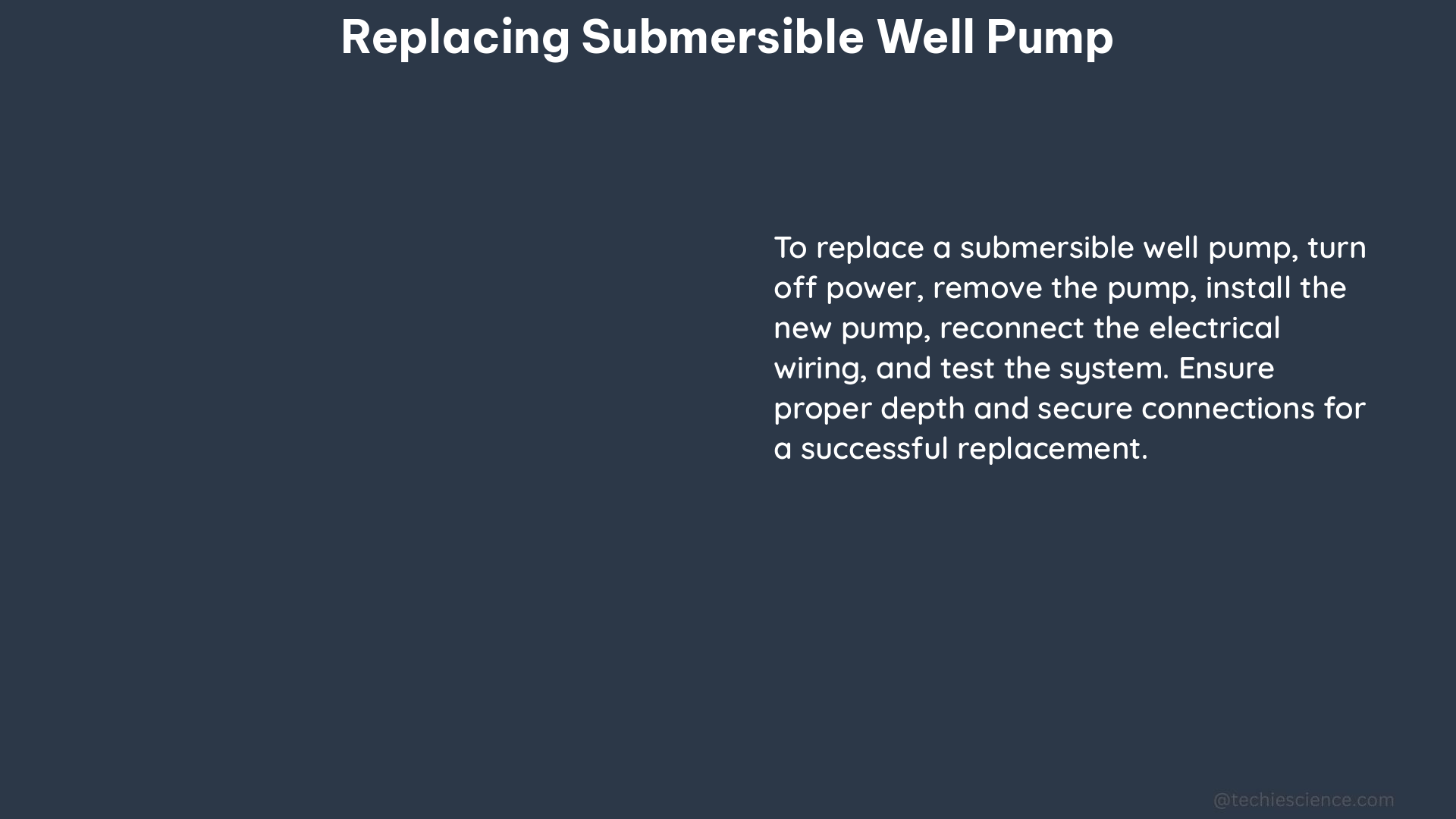Replacing a submersible well pump is a crucial task for homeowners with a private well system. This comprehensive guide will walk you through the process step-by-step, providing technical details and expert insights to ensure a successful and efficient replacement.
Understanding Submersible Well Pumps
Submersible well pumps are designed to be submerged in the well, typically at the bottom, and are responsible for drawing water from the aquifer and delivering it to the home’s plumbing system. These pumps are typically powered by a 220V or 240V electrical system and can vary in size and capacity depending on the depth of the well and the household’s water usage.
Lifespan and Failure Indicators
The average lifespan of a submersible well pump can range from 8 to 15 years, though some high-quality models may last up to 20 years or more. Factors that can impact the pump’s lifespan include water quality, usage patterns, and the overall maintenance of the well system.
Some common signs that a submersible well pump may be nearing the end of its lifespan include:
- Decreased water pressure or flow
- Increased energy consumption or tripping circuit breakers
- Frequent cycling of the pump
- Presence of sediment or debris in the water
- Visible wear or damage to the pump’s exterior
By monitoring these indicators, homeowners can proactively plan for a well pump replacement and avoid unexpected system failures.
Preparing for Replacement

Before beginning the replacement process, it’s essential to gather the necessary tools and materials. This includes:
- Submersible well pump (size and capacity matched to your well)
- Electrical wire (14-3 or 12-3 gauge, depending on the pump’s power requirements)
- Shrink tubing and crimps for secure wire connections
- Pipe wrenches, pliers, and other basic hand tools
- Bleach or chlorine solution for disinfecting the well
Additionally, it’s crucial to have a clear understanding of the well’s depth, the current pump’s specifications, and the overall water usage requirements of the household. This information will help you select the appropriate replacement pump and ensure a seamless installation.
Replacing the Submersible Well Pump
The process of replacing a submersible well pump can be divided into the following steps:
-
Shut off power and disconnect the existing pump: Locate the circuit breaker or disconnect switch that controls the well pump and turn off the power. Disconnect the electrical wires from the pump, taking note of their positions for proper reconnection later.
-
Remove the existing pump: Use pipe wrenches to loosen and disconnect the pump from the drop pipe and pitless adapter. Carefully pull the pump out of the well, taking care not to damage the drop pipe or electrical wiring.
-
Inspect the well and drop pipe: Visually inspect the well casing and drop pipe for any signs of damage or corrosion. Clean the well and drop pipe as needed to prepare for the new pump installation.
-
Install the new submersible well pump: Lower the new pump into the well, ensuring that the electrical wiring is properly routed and secured. Use the pipe wrenches to tighten the connections to the drop pipe and pitless adapter.
-
Wire the new pump: Connect the electrical wires to the new pump, matching the colors and positions from the previous installation. Use shrink tubing and crimps to ensure a secure and waterproof connection.
-
Disinfect the well: Pour a chlorine solution (typically 1 cup of household bleach per 100 gallons of well water) into the well to disinfect the system.
-
Test the new pump: Turn the power back on and check for proper operation, monitoring the water pressure, flow, and any unusual noises or vibrations.
-
Replace the pressure tank: If the pressure tank is also old or in poor condition, consider replacing it at the same time as the well pump. This can help ensure the entire well system is operating at peak efficiency.
Throughout the replacement process, it’s essential to follow all local and national electrical codes, as well as any specific manufacturer instructions for the new submersible well pump.
Optimizing Well Pump Performance
To ensure the longevity and efficiency of the new submersible well pump, consider the following maintenance and optimization tips:
- Regularly inspect the well and pump for any signs of wear or damage
- Monitor the pump’s energy consumption and water output to identify any performance issues
- Maintain the well system by periodically shocking the well with chlorine to prevent bacterial growth
- Consider upgrading to a more energy-efficient pump model if the existing one is outdated or inefficient
- Ensure the pressure tank is properly sized and functioning correctly to prevent short-cycling of the pump
By following these best practices, homeowners can maximize the lifespan and performance of their submersible well pump, ensuring a reliable and cost-effective water supply for years to come.
Conclusion
Replacing a submersible well pump is a critical task for homeowners with a private well system. By understanding the technical details, following a step-by-step process, and implementing proper maintenance practices, you can ensure a successful and efficient replacement that will keep your well system running smoothly for years to come.
References:
- Recommended Strategy for Eventual Well Pump Replacement
- Diagnose and Replace a Submersible Well Pump
- When Should I Replace My Well Pump?
- Well Pump Replacement: A Step-by-Step Guide
- Submersible Well Pump Replacement: What You Need to Know

The lambdageeks.com Core SME Team is a group of experienced subject matter experts from diverse scientific and technical fields including Physics, Chemistry, Technology,Electronics & Electrical Engineering, Automotive, Mechanical Engineering. Our team collaborates to create high-quality, well-researched articles on a wide range of science and technology topics for the lambdageeks.com website.
All Our Senior SME are having more than 7 Years of experience in the respective fields . They are either Working Industry Professionals or assocaited With different Universities. Refer Our Authors Page to get to know About our Core SMEs.